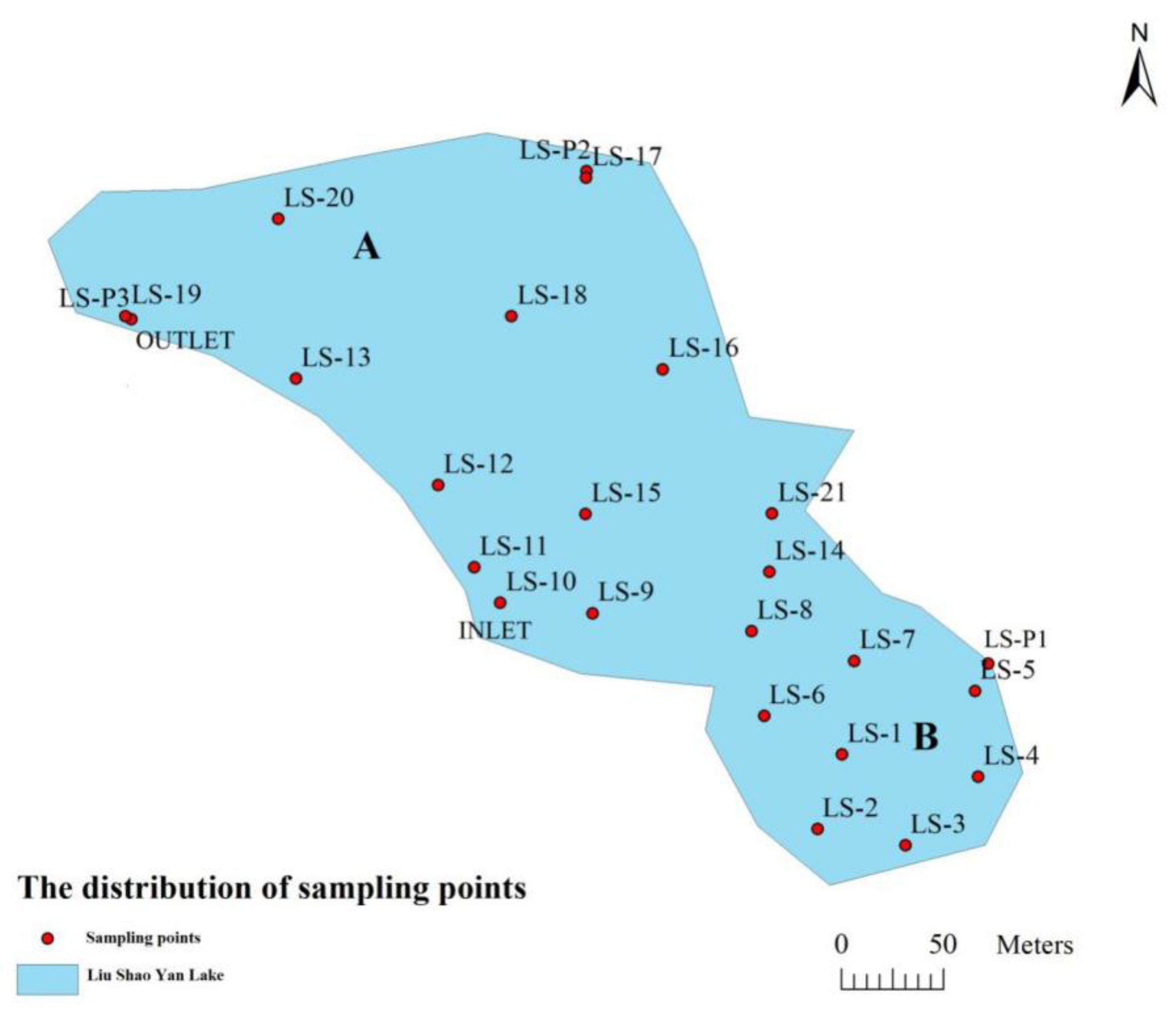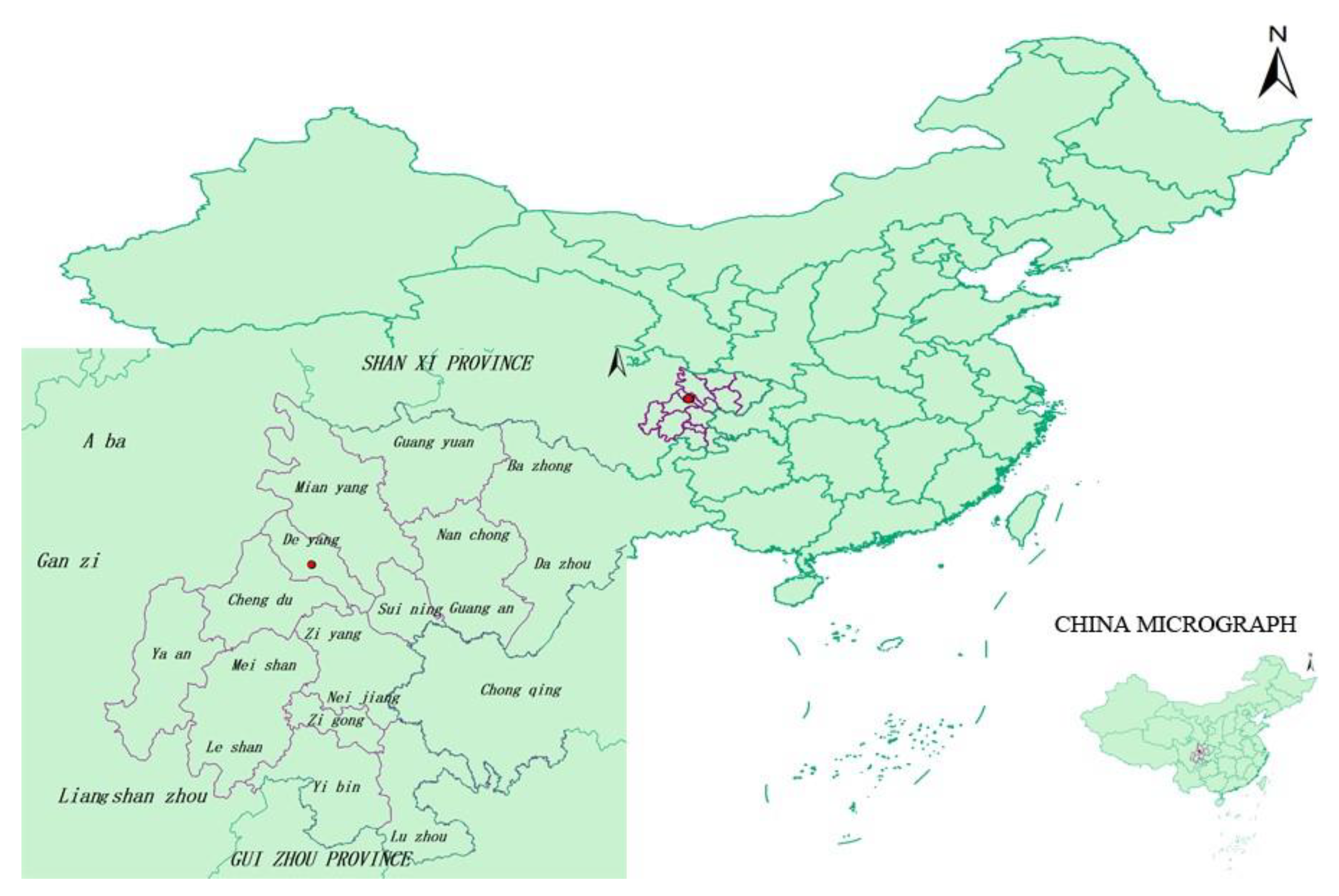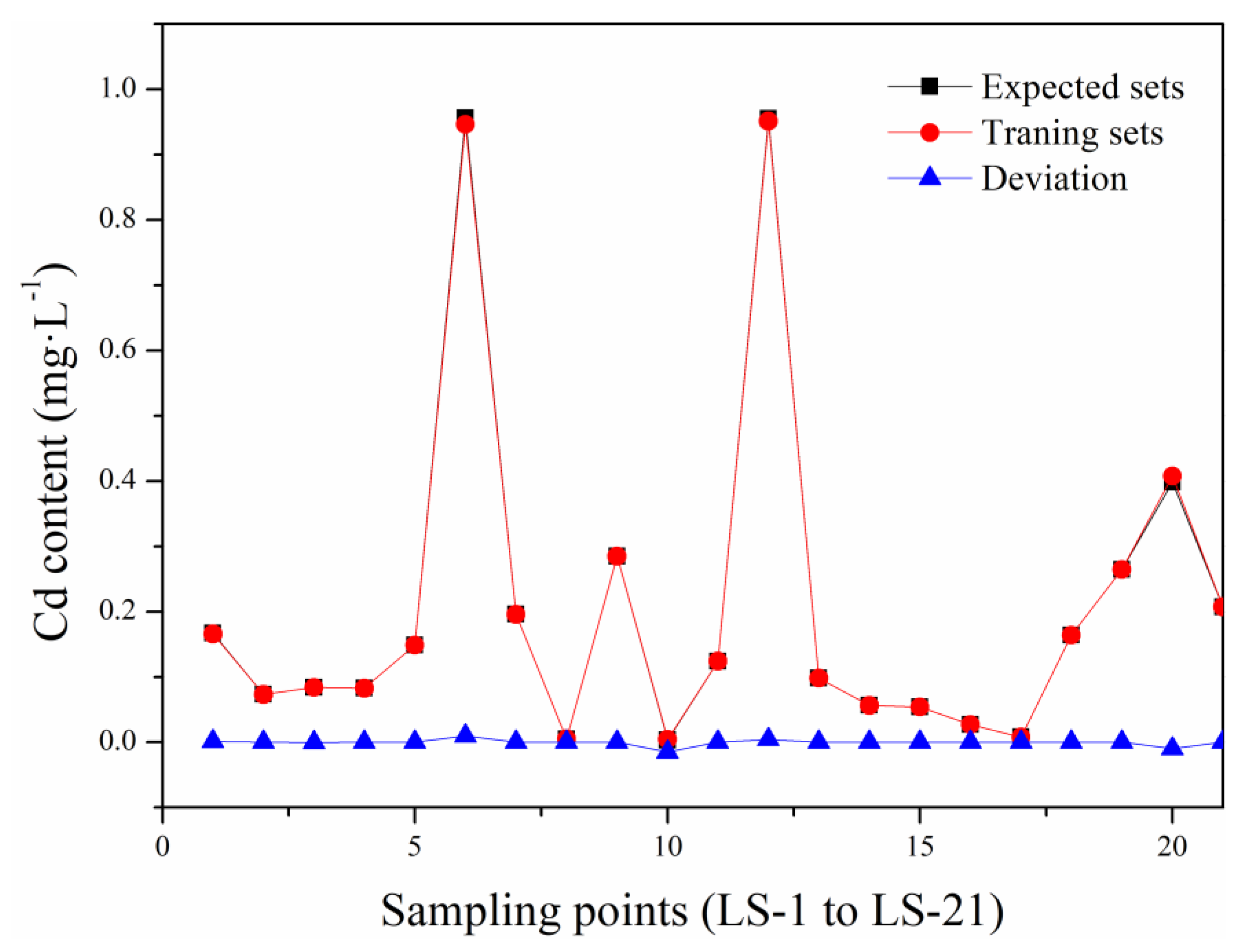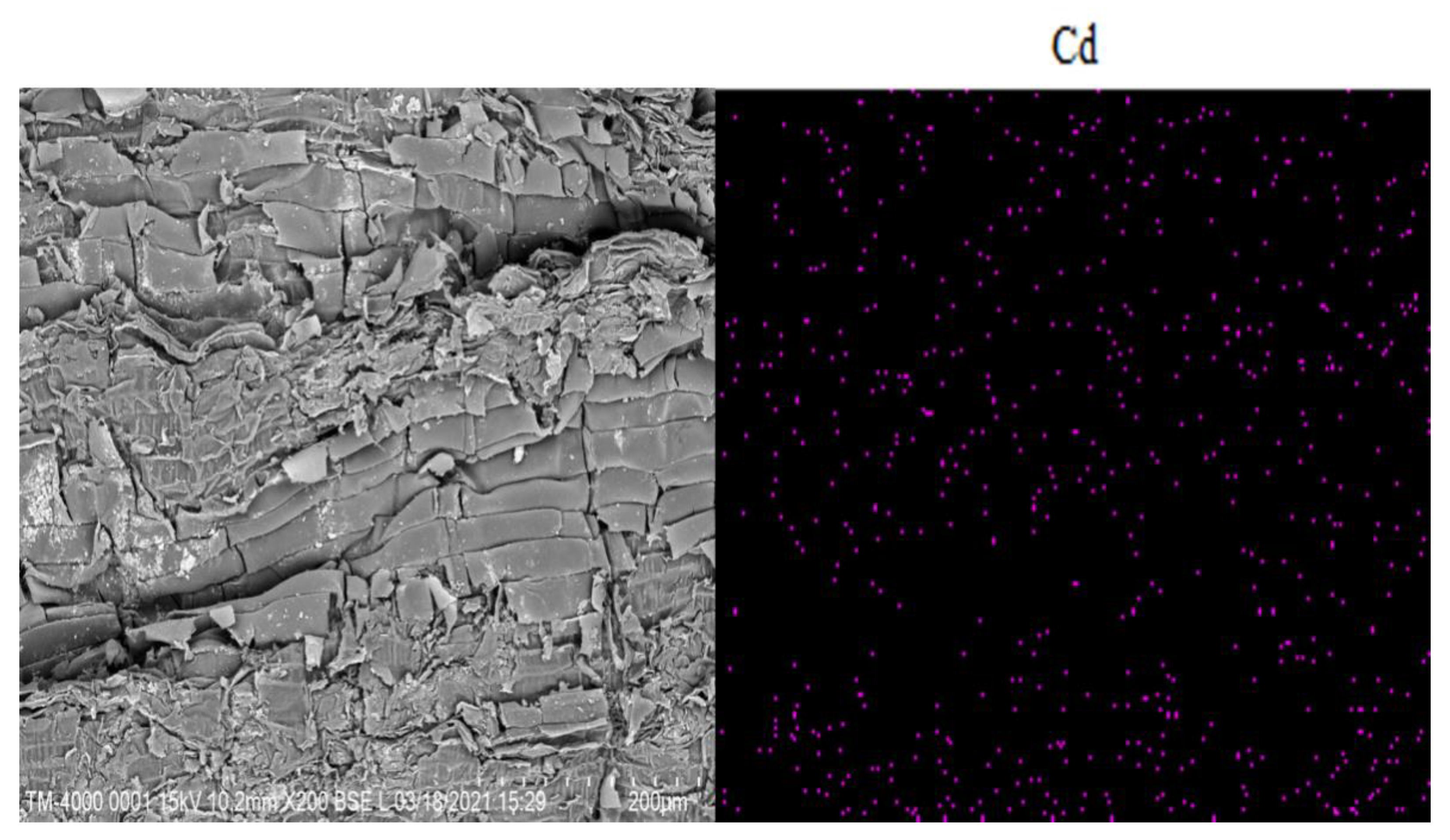Horizontal Distribution of Cadmium in Urban Constructed Wetlands: A Case Study
Abstract
1. Introduction
- Reclamation of wastes: Permits wastewater to be used as a water source in wetland ecosystems [17];
- Economic output: Serves as a production base for economic crops and medicinal plants [18];
- Landscape value: Landscaping designed for environmental purposes;
- Extensive applications: Applicable for urban development zones, rural farms [19], and pollutant discharge areas.
2. Materials and Methods
2.1. Data Acquisition
2.2. Establishment of the Artificial Neural Network
3. Results and Discussion
- Flow into Zone B: LS-10⟶LS-9⟶LS-8 and LS-14⟶B;
- Flow to the lake center: LS-10⟶LS-15⟶LS-16⟶LS-17;
- Flow to the outlet in Zone A: LS-10⟶LS-11⟶LS-12⟶LS-13⟶LS-20⟶LS-19.
- CV represents the coefficient of variation (%);
- s represents the sample standard deviation;represents the sample mean.
4. Conclusions
Author Contributions
Funding
Institutional Review Board Statement
Informed Consent Statement
Data Availability Statements
Conflicts of Interest
References
- Otero, I.; Kallis, G.; Aguilar, R.; Ruiz, V. Water scarcity, social power and the production of an elite suburb: The political ecology of water in Matadepera, Catalonia. Ecol. Econ. 2011, 70, 1297–1308. [Google Scholar] [CrossRef]
- Bogardi, J.J.; Dudgeon, D.; Lawford, R.; Flinkerbusch, E.; Meyn, A.; Pahl-Wostl, C.; Viehlhauer, K.; Vörösmarty, C. Water security for a planet under pressure: Interconnected challenges of a changing world call for sustainable solutions. Curr. Opin. Environ. Sustain. 2012, 4, 35–43. [Google Scholar] [CrossRef]
- Trenberth, K.E.; Dai, A.; Van Der Schrier, G.; Jones, P.D.; Barichivich, J.; Briffa, K.R.; Sheffield, J. Global warming and changes in drought. Nat. Clim. Chang. 2014, 4, 17–22. [Google Scholar] [CrossRef]
- UNESCO. The United Nations World Water Development Report 3: Water in a Changing World; UNESCO: Paris, France; Berghahn Books: New York, NY, USA, 2009. [Google Scholar]
- Schwarzenbach, R.P.; Escher, B.I.; Fenner, K.; Hofstetter, T.B.; Johnson, C.A.; Von Gunten, U.; Wehrli, B. The challenge of micropollutants in aquatic systems. Science 2006, 313, 1072–1077. [Google Scholar] [CrossRef]
- Peng, T.; Deng, H. Comprehensive evaluation on water resource carrying capacity based on DPESBR framework: A case study in Guiyang, southwest China. J. Clean. Prod. 2020, 268, 122235. [Google Scholar] [CrossRef]
- Zhao, J.; Xu, T.; Xiao, J.; Liu, S.; Mao, K.; Song, L.; Yao, Y.; He, X.; Feng, H. Responses of water use efficiency to drought in southwest China. Remote Sens. 2020, 12, 199. [Google Scholar] [CrossRef]
- Zang, W.; Lin, J.; Wang, Y.; Tao, H. Investigating small-scale water pollution with UAV remote sensing technology. In Proceedings of the World Automation Congress 2012, Puerto Vallarta, Mexico, 24–28 June 2012; IEEE: Beijing, China, 2012; pp. 1–4. [Google Scholar]
- Cheng, S.; Wu, Z.; Kuang, Q. Macrophytes in Artificial Wetland. J. Lake Sci. 2002, 14, 179–184. [Google Scholar]
- Gerba, C.P.; Thurston, J.A.; Falabi, J.A.; Watt, P.M.; Karpiscak, M.M. Optimization of artificial wetland design for removal of indicator microorganisms and pathogenic protozoa. Water Sci. Technol. 1999, 40, 363–368. [Google Scholar] [CrossRef]
- Miklas, S. Chapter 20—Constructed Wetlands. In Wetlands for Water Pollution Control, 2nd ed.; Miklas, S., Ed.; Elsevier: Amsterdam, The Netherlands, 2016; pp. 137–155. [Google Scholar]
- Bai, X.; Wang, B.; Yu, M.; Nie, M. Development of constructed wetland wastewater treatment technology and its application in China. J. Harbin Univ. Civ. Eng. Archit. 1999, 32, 88–92. [Google Scholar]
- Xianguo, L.; Ming, J. Progress and prospect of wetland research in China. J. Geogr. Sci. 2004, 14, 45–51. [Google Scholar] [CrossRef]
- Lee, C.; Fletcher, T.D.; Sun, G. Nitrogen removal in constructed wetland systems. Eng. Life Sci. 2009, 9, 11–22. [Google Scholar] [CrossRef]
- Drizo, A.; Frost, C.A.; Grace, J.; Smith, K.A. Physico-chemical screening of phosphate-removing substrates for use in constructed wetland systems. Water Res. 1999, 33, 3595–3602. [Google Scholar] [CrossRef]
- Salmon, C.; Crabos, J.L.; Sambuco, J.P.; Bessiere, J.M.; Basseres, A.; Caumette, P.; Baccou, J.C. Artificial wetland performances in the purification efficiency of hydrocarbon wastewater. Water Air Soil Pollut. 1998, 104, 313–329. [Google Scholar] [CrossRef]
- Vrhovšek, D.; Kukanja, V.; Bulc, T. Constructed wetland (CW) for industrial waste water treatment. Water Res. 1996, 30, 2287–2292. [Google Scholar] [CrossRef]
- Shelef, O.; Gross, A.; Rachmilevitch, S. Role of plants in a constructed wetland: Current and new perspectives. Water 2013, 5, 405–419. [Google Scholar] [CrossRef]
- Jucherski, A.; Nastawny, M.; Walczowski, A.; Jóźwiakowski, K.; Gajewska, M. Assessment of the technological reliability of a hybrid constructed wetland for wastewater treatment in a mountain eco-tourist farm in Poland. Water Sci. Technol. 2017, 75, 2649–2658. [Google Scholar] [CrossRef] [PubMed]
- Yao, Q.; Yu, J.; Lei, J. A decentralized wastewater treatment project for a “new rural” community in Wuhan. China Water Wastewater 2009, 25, 37–39. (In Chinese) [Google Scholar]
- Brooks, A.S.; Rozenwald, M.N.; Geohring, L.D.; Lion, L.W.; Steenhuis, T.S. Phosphorus removal by wollastonite: A constructed wetland substrate. Ecol. Eng. 2000, 15, 121–132. [Google Scholar] [CrossRef]
- Singh, S.; Chakraborty, S. Performance of organic substrate amended constructed wetland treating acid mine drainage (AMD) of North-Eastern India. J. Hazard. Mater. 2020, 397, 122719. [Google Scholar] [CrossRef]
- Zeng, Z.; Luo, W.-G.; Wang, Z.; Yi, F.-C. Water pollution and its causes in the Tuojiang River Basin, China: An artificial neural network analysis. Sustainability 2021, 13, 792. [Google Scholar] [CrossRef]
- Cheng, S.; Grosse, W.; Karrenbrock, F.; Thoennessen, M. Efficiency of constructed wetlands in decontamination of water polluted by heavy metals. Ecol. Eng. 2002, 18, 317–325. [Google Scholar] [CrossRef]
- Khan, S.; Ahmad, I.; Shah, M.T.; Rehman, S.; Khaliq, A. Use of constructed wetland for the removal of heavy metals from industrial wastewater. J. Environ. Manag. 2009, 90, 3451–3457. [Google Scholar] [CrossRef]
- Liu, J.; Dong, Y.; Xu, H.; Wang, D.; Xu, J. Accumulation of Cd, Pb and Zn by 19 wetland plant species in constructed wetland. J. Hazard. Mater. 2007, 147, 947–953. [Google Scholar] [CrossRef]
- Leung, H.M.; Duzgoren-Aydin, N.S.; Au, C.K.; Krupanidhi, S.; Fung, K.Y.; Cheung, K.C.; Wong, Y.K.; Peng, X.L.; Ye, Z.H.; Yung, K.K.L.; et al. Monitoring and assessment of heavy metal contamination in a constructed wetland in Shaoguan (Guangdong Province, China): Bioaccumulation of Pb, Zn, Cu and Cd in aquatic and terrestrial components. Environ. Sci. Pollut. Res. 2017, 24, 9079–9088. [Google Scholar] [CrossRef] [PubMed]
- Gill, L.W.; Ring, P.; Casey, B.; Higgins, N.M.P.; Johnston, P.M. Long term heavy metal removal by a constructed wetland treating rainfall runoff from a motorway. Sci. Total Environ. 2017, 601–602, 32–44. [Google Scholar] [CrossRef] [PubMed]
- Ayaz, T.; Khan, S.; Khan, A.Z.; Lei, M.; Alam, M. Remediation of industrial wastewater using four hydrophyte species: A comparison of individual (pot experiments) and mix plants (constructed wetland). J. Environ. Manag. 2020, 255, 109833. [Google Scholar] [CrossRef]
- Bezbaruah, A.N.; Zhang, T.C. PH, redox, and oxygen microprofiles in rhizosphere of bulrush (Scirpus validus) in a constructed wetland treating municipal wastewater. Biotechnol. Bioeng. 2004, 88, 60–70. [Google Scholar] [CrossRef]
- Camacho, J.V.; Martínez, A.D.L.; Gómez, R.G.; Sanz, J.M. A comparative study of five horizontal subsurface flow constructed wetlands using different plant species for domestic wastewater treatment. Environ. Technol. 2007, 28, 1333–1343. [Google Scholar] [CrossRef]
- Cooper, P. What can we learn from old wetlands? Lessons that have been learned and some that may have been forgotten over the past 20 years. Desalination 2009, 246, 11–26. [Google Scholar] [CrossRef]
- Picek, T.; Čížková, H.; Dušek, J. Greenhouse gas emissions from a constructed wetland—Plants as important sources of carbon. Ecol. Eng. 2007, 31, 98–106. [Google Scholar] [CrossRef]
- Ström, L.; Lamppa, A.; Christensen, T.R. Greenhouse gas emissions from a constructed wetland in southern Sweden. Wetl. Ecol. Manag. 2007, 15, 43–50. [Google Scholar] [CrossRef]
- Zhuang, L.-L.; Yang, T.; Zhang, J.; Li, X. The configuration, purification effect and mechanism of intensified constructed wetland for wastewater treatment from the aspect of nitrogen removal: A review. Bioresour. Technol. 2019, 293, 122086. [Google Scholar] [CrossRef] [PubMed]
- Dixit, G.; Roy, D.; Uppal, N. Predicting India volatility index: An application of artificial neural network. Int. J. Comput. Appl. 2013, 70. [Google Scholar] [CrossRef]
- Lei, W.; Ruliang, W.; Hongfeng, Q.; Yang, X. Improved BP neural network algorithm and its application. Softw. Guide 2016, 15, 38–40. (In Chinese) [Google Scholar]
- Wang, R. Prediction of Wastewater Treatment Based on Geneticalgorithm Optimization BP Artificial Neural Network. Ph.D. Thesis, South China University of Technology, Guangzhou, China, 2012. (In Chinese). [Google Scholar]
- Cho, K.; Van Merriënboer, B.; Gulcehre, C.; Bahdanau, D.; Bougares, F.; Schwenk, H.; Bengio, Y. Learning phrase representations using RNN encoder-decoder for statistical machine translation. arXiv 2014, arXiv:1406.1078. [Google Scholar]
- Yin, W.; Kann, K.; Yu, M.; Schütze, H. Comparative study of CNN and RNN for natural language processing. arXiv 2017, arXiv:1702.01923. [Google Scholar]
- Sherstinsky, A. Fundamentals of recurrent neural network (RNN) and long short-term memory (LSTM) network. Phys. D Nonlinear Phenom. 2020, 404, 132306. [Google Scholar] [CrossRef]
- Wang, F.; Tang, Y. Application of artificial neural network in water quality evaluation of Daqing River. Northeast. Water Conserv. Hydropower. 2019, 37, 25–35. (In Chinese) [Google Scholar]
- Jun, Z.; Zhen, Z.; Zhe, Z.; Jin, H.; Zu, H. Water quality modeling for water works in the Minjiang River estuary based on BP neural network model. Environ. Sci. Technol. 2020, 43, 198–203. (In Chinese) [Google Scholar]
- Ghiassi, M.; Zimbra, D.K.; Saidane, H. Urban water demand forecasting with a dynamic artificial neural network model. J. Water Resour. Plan. Manag. 2008, 2, 134. [Google Scholar] [CrossRef]
- Firat, M.; Yurdusev, M.A.; Turan, M.E. Evaluation of artificial neural network techniques for municipal water consumption modeling. Water Resour. Manag. 2009, 23, 617–632. [Google Scholar] [CrossRef]
- Li, X.; Zheng, D.; Yang, J.; Cai, H.; Zeng, W.; Yue, R. Research on prediction and early warning model of water quality in construction area based on GA-BP neural network. J. Chongqing Jiaotong Univ. Nat. Sci. Ed. 2020, 39, 106–110. (In Chinese) [Google Scholar]
- Wang, G.; Xie, J.; Zhang, J. Application of GA-BP combination forecasting method into the annual run-off prediction of Beiluo River. Agric. Res. Arid. Areas 2014, 32, 203–207. (In Chinese) [Google Scholar]
- Yan, X.K.; Wang, J.Y. Research of construction subcontracting enterprise competence based on GA-BP neural network. Adv. Mater. Res. 2014, 1030–1032, 2664–2667. [Google Scholar] [CrossRef]
- GB 12998-1991. Water Quality-Guidance on Sampling Techniques; Chinese Standards Press: Beijing, China, 1991. [Google Scholar]
- Zhuang, P.; McBride, M.B.; Xia, H.; Li, N.; Li, Z. Health risk from heavy metals via consumption of food crops in the vicinity of Dabaoshan mine, South China. Sci. Total Environ. 2009, 407, 1551–1561. [Google Scholar] [CrossRef] [PubMed]
- Bing, H.; Wu, Y.; Liu, E.; Yang, X. Assessment of heavy metal enrichment and its human impact in lacustrine sediments from four lakes in the mid-low reaches of the Yangtze River, China. J. Environ. Sci. 2013, 25, 1300–1309. [Google Scholar] [CrossRef]
- Lu, J.; Zhong, X.; Wu, H.; Wang, H. Vertical distribution characteristics of heavy metals in lake water at different flow rates. Trans. Chin. Soc. Agric. Mach. 2016, 47, 179–184. (In Chinese) [Google Scholar]
- Semesi, I.S.; Beer, S.; Björk, M. Seagrass photosynthesis controls rates of calcification and photosynthesis of calcareous macroalgae in a tropical seagrass meadow. Mar. Ecol. Prog. Ser. 2009, 382, 41–47. [Google Scholar] [CrossRef]
- Dang, F.; Wu, Q.; Ke, L. Study on the relationship between cyanobacteria bloom and pH value in Chaohu Lake. Chem. Eng. Des. Commun. 2018, 44, 202–203. [Google Scholar]
- Zhou, Q.; Liu, Y.; Li, T.; Zhao, H.; Alessi, D.S.; Liu, W.; Konhauser, K.O. Cadmium adsorption to clay-microbe aggregates: Implications for marine heavy metals cycling. Geochim. Cosmochim. Acta 2020, 290, 124–136. [Google Scholar] [CrossRef]
- Zhu, Z.; Yang, X.; Wang, K.; Huang, H.; Zhang, X.; Fang, H.; Li, T.; Alva, A.K.; He, Z. Bioremediation of Cd-DDT co-contaminated soil using the Cd-hyperaccumulator Sedum alfredii and DDT-degrading microbes. J. Hazard. Mater. 2012, 235–236, 144–151. [Google Scholar] [CrossRef] [PubMed]
- Meng, W.; Liu, Y.; Zhu, S.; Wang, Z.; Wang, F. Dongting lake basin sediment distribution characteristics of heavy metals and their ecological risk. South North Water Divers. Water Conserv. Sci. Technol. 2021, 1–12, (Both in English and Chinese). Available online: http://kns.cnki.net/kcms/detail/13.1430.tv.20210118.1733.002.html (accessed on 5 September 2011).
- Luo, Y.M. Phytoremediation of metal-contaminated soil. Soil 1999, 31, 261–265, 280. (In Chinese) [Google Scholar]
- He, Q. Progress in screening cadmium superenriched plants. Environ. Prot. Circ. Econ. 2013, 33, 46–49. (In Chinese) [Google Scholar]
- Sun, T.; Zhang, Y.; Cai, T. Research progress on heavy metal tolerance mechanism of Brassica juncea, L. Chin. J. Ecol. Agric. 2011, 19, 226–234. (In Chinese) [Google Scholar]
- Fang, M. Enrichment Characteristics of Cd and Plant Remediation of Cd Contaminated Soil by Averrhoa Carambola. Ph.D. Thesis, Sun Yat-sen University, Guangzhou, China, 2008. (In Chinese). [Google Scholar]
- Saoussen, B.; Helmi, H.; Shino, M.; Yoshiro, O. Hyperaccumulator Thlaspi caerulescens (Ganges ecotype) response to increasing levels of dissolved cadmium and zinc. Chem. Ecol. 2012, 28, 561–573. [Google Scholar] [CrossRef]
- Hou, W.; Chen, X.; Song, G.; Wang, Q.; Chang, C.C. Effects of copper and cadmium on heavy metal polluted waterbody restoration by duckweed (Lemna minor). Plant Physiol. Biochem. 2007, 45, 62–69. [Google Scholar] [CrossRef]
- Patra, M.; Bhowmik, N.; Bandopadhyay, B.; Sharma, A. Comparison of mercury, lead and arsenic with respect to genotoxic effects on plant systems and the development of genetic tolerance. Environ. Exp. Bot. 2004, 52, 199–223. [Google Scholar] [CrossRef]
- Shen, Z.-G.; Li, X.-D.; Wang, C.-C.; Chen, H.-M.; Chua, H. Lead phytoextraction from contaminated soil with high-biomass plant species. J. Environ. Qual. 2002, 31, 1893–1900. [Google Scholar] [CrossRef]
- Xin, J.; Ma, S.; Li, Y.; Zhao, C.; Tian, R. Pontederia cordata, an ornamental aquatic macrophyte with great potential in phytoremediation of heavy-metal-contaminated wetlands. Ecotoxicol. Environ. Saf. 2020, 203, 111024. [Google Scholar] [CrossRef] [PubMed]
- Brooks, C.; Schopohl, L. Green accounting and finance: Advancing research on environmental disclosure, value impacts and management control systems. Br. Account. Rev. 2021, 53, 100973. [Google Scholar] [CrossRef]
- Falcone, P.M. Environmental regulation and green investments: The role of green finance. Int. J. Green Econ. 2020, 14, 159. [Google Scholar] [CrossRef]







| Sampling Points | Cd Content in Water Body Ⅰ (mg/L) | Cd Content in Water Body Ⅱ (mg/L) | Cd Content in Sediment (mg/L) |
|---|---|---|---|
| LS-1 | 0.1520 | 0.1670 | 0.4917 |
| LS-2 | 0.0873 | 0.0732 | ND |
| LS-3 | 0.0867 | 0.0840 | ND |
| LS-4 | 0.0998 | 0.0826 | ND |
| LS-5 | 0.8649 | 0.1486 | ND |
| LS-6 | 0.2132 | 0.9565 | ND |
| LS-7 | 0.0033 | 0.1960 | 0.0633 |
| LS-8 | 0.3856 | 0.0050 | \ |
| LS-9 | 0.0042 | 0.2850 | \ |
| LS-10 (INLET) | 0.1138 | 0.0030 | ND |
| LS-11 | 0.1111 | 0.1240 | \ |
| LS-12 | 0.8999 | 0.9555 | \ |
| LS-13 | 0.0899 | 0.0980 | \ |
| LS-14 | 0.0612 | 0.0562 | \ |
| LS-15 | 0.0555 | 0.0540 | \ |
| LS-16 | 0.0212 | 0.0270 | \ |
| LS-17 | 0.0071 | 0.0080 | \ |
| LS-18 | 0.1633 | 0.1640 | \ |
| LS-19 (OUTLET) | 0.2547 | 0.2647 | ND |
| LS-20 | 0.3989 | 0.3980 | \ |
| LS-21 | 0.2074 | 0.2073 | \ |
| Sampling Points | Training Sets (mg/L) | Expected Sets (mg/L) | Training Results Sets (mg/L) | Deviation | Predicted Results Sets (mg/L) |
|---|---|---|---|---|---|
| LS-1 | 0.1520 | 0.1670 | 0.166 | 1 × 10−3 | 0.142 |
| LS-2 | 0.0873 | 0.0732 | 0.0731 | 1 × 10−4 | 0.0637 |
| LS-3 | 0.0867 | 0.0840 | 0.0841 | −1 × 10−4 | 0.0731 |
| LS-4 | 0.0998 | 0.0826 | 0.08263 | −3 × 10−5 | 0.0719 |
| LS-5 | 0.8649 | 0.1486 | 0.1486 | 0 | 0.0129 |
| LS-6 | 0.2132 | 0.9565 | 0.9465 | 1 × 10−2 | 0.8322 |
| LS-7 | 0.0033 | 0.1960 | 0.196 | 0 | 0.1725 |
| LS-8 | 0.3856 | 0.0050 | 0.005 | 0 | 0.0042 |
| LS-9 | 0.0042 | 0.2850 | 0.285 | 0 | 0.2280 |
| LS-10 (INLET) | 0.1138 | 0.0030 | 0.0045 | −1.5 × 10−3 | 0.0025 |
| LS-11 | 0.1111 | 0.1240 | 0.124 | 0 | 0.0955 |
| LS-12 | 0.8999 | 0.9555 | 0.9515 | 4 × 10−3 | 0.7357 |
| LS-13 | 0.0899 | 0.0980 | 0.098 | 0 | 0.0794 |
| LS-14 | 0.0612 | 0.0562 | 0.0562 | −3 × 10−10 | 0.0472 |
| LS-15 | 0.0555 | 0.0540 | 0.054 | 0 | 0.0410 |
| LS-16 | 0.0212 | 0.0270 | 0.026999 | 6 × 10−7 | 0.0213 |
| LS-17 | 0.0071 | 0.0080 | 0.008002 | −2 × 10−6 | 0.007 |
| LS-18 | 0.1633 | 0.1640 | 0.164 | 0 | 0.1345 |
| LS-19 (OUTLET) | 0.2547 | 0.2647 | 0.2647 | 0 | 0.1985 |
| LS-20 | 0.3989 | 0.3980 | 0.408 | −1 × 10−2 | 0.3423 |
| LS-21 | 0.2074 | 0.2073 | 0.2073 | 0 | 0.1721 |
| Sampling Points | pH | Flow Velocity (cm·s−1) |
|---|---|---|
| LS-1 | 8.42 | 6 |
| LS-2 | 8.64 | 3 |
| LS-3 | 8.28 | 3 |
| LS-4 | 8.21 | 4 |
| LS-5 | 8.27 | 2 |
| LS-6 | 8.27 | 7 |
| LS-7 | 8.02 | 9 |
| LS-8 | 8.13 | 17 |
| LS-9 | 8.21 | 14 |
| LS-10 (INLET) | 8.19 | 15 |
| LS-11 | 7.80 | 14 |
| LS-12 | 8.47 | 7 |
| LS-13 | 8.41 | 4 |
| LS-14 | 8.06 | 10 |
| LS-15 | 8.10 | 12 |
| LS-16 | 8.22 | 1 |
| LS-17 | 8.26 | 1 |
| LS-18 | 8.17 | 6 |
| LS-19 (OUTLET) | 7.96 | 6 |
| LS-20 | 8.07 | 4 |
| LS-21 | 8.05 | 4 |
Publisher’s Note: MDPI stays neutral with regard to jurisdictional claims in published maps and institutional affiliations. |
© 2021 by the authors. Licensee MDPI, Basel, Switzerland. This article is an open access article distributed under the terms and conditions of the Creative Commons Attribution (CC BY) license (https://creativecommons.org/licenses/by/4.0/).
Share and Cite
Zeng, Z.; Luo, W.-G.; Yi, F.-C.; Huang, F.-Y.; Wang, C.-X.; Zhang, Y.-P.; Cheng, Q.-Q.; Wang, Z. Horizontal Distribution of Cadmium in Urban Constructed Wetlands: A Case Study. Sustainability 2021, 13, 5381. https://doi.org/10.3390/su13105381
Zeng Z, Luo W-G, Yi F-C, Huang F-Y, Wang C-X, Zhang Y-P, Cheng Q-Q, Wang Z. Horizontal Distribution of Cadmium in Urban Constructed Wetlands: A Case Study. Sustainability. 2021; 13(10):5381. https://doi.org/10.3390/su13105381
Chicago/Turabian StyleZeng, Zheng, Wei-Ge Luo, Fa-Cheng Yi, Feng-Yu Huang, Cheng-Xia Wang, Yi-Ping Zhang, Qiang-Qiang Cheng, and Zhe Wang. 2021. "Horizontal Distribution of Cadmium in Urban Constructed Wetlands: A Case Study" Sustainability 13, no. 10: 5381. https://doi.org/10.3390/su13105381
APA StyleZeng, Z., Luo, W.-G., Yi, F.-C., Huang, F.-Y., Wang, C.-X., Zhang, Y.-P., Cheng, Q.-Q., & Wang, Z. (2021). Horizontal Distribution of Cadmium in Urban Constructed Wetlands: A Case Study. Sustainability, 13(10), 5381. https://doi.org/10.3390/su13105381







